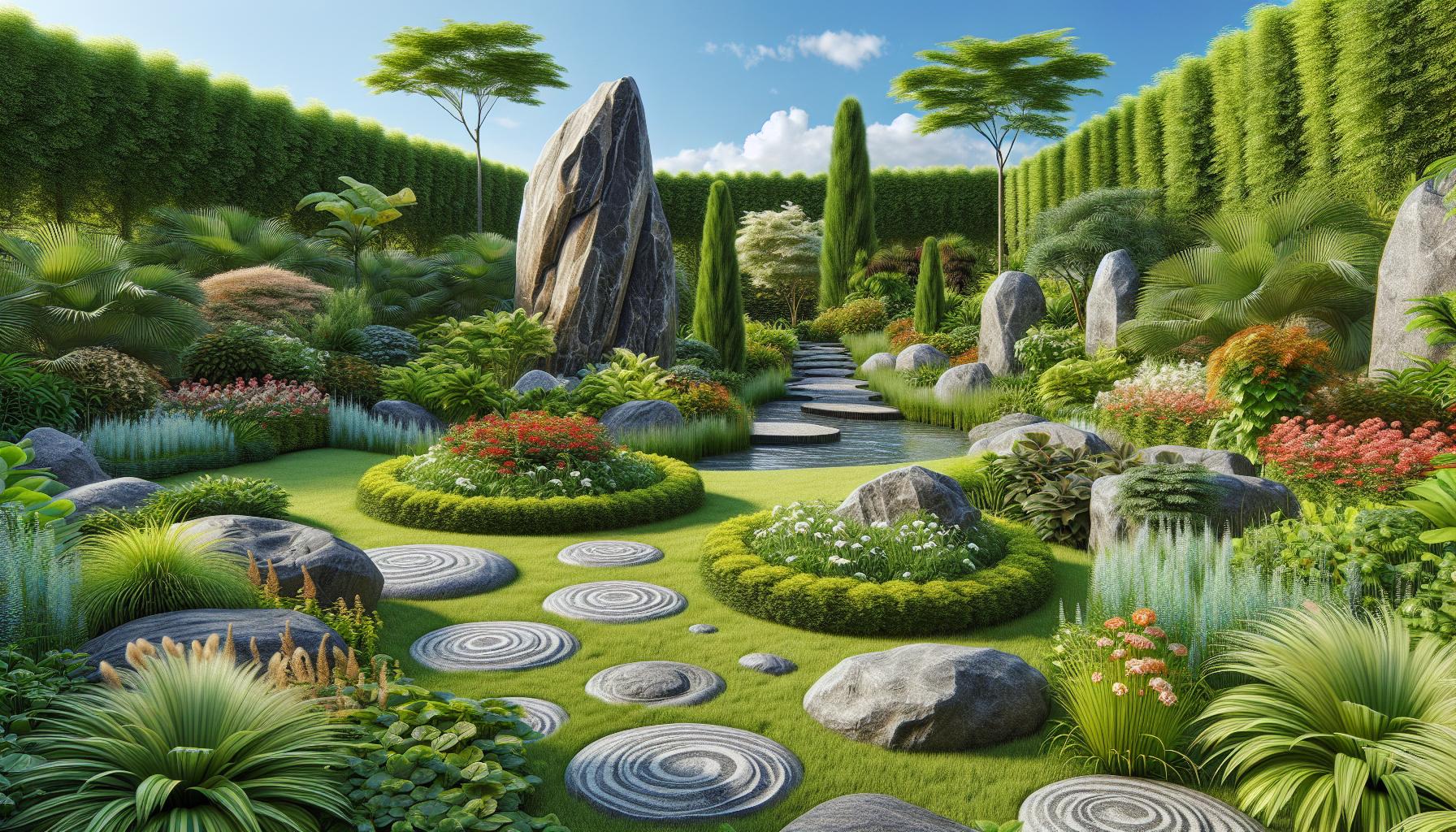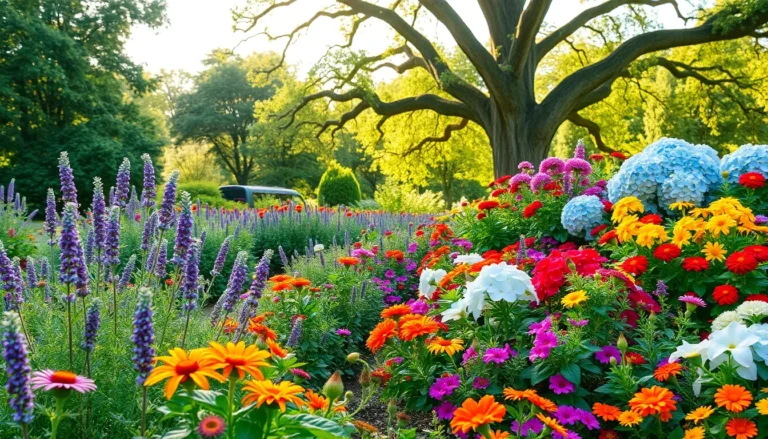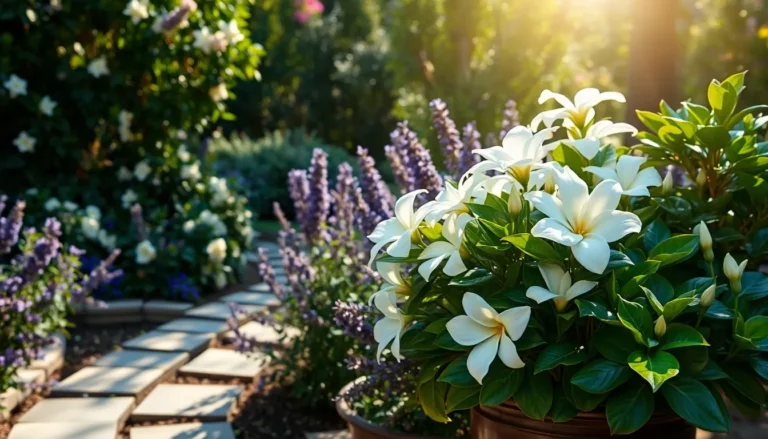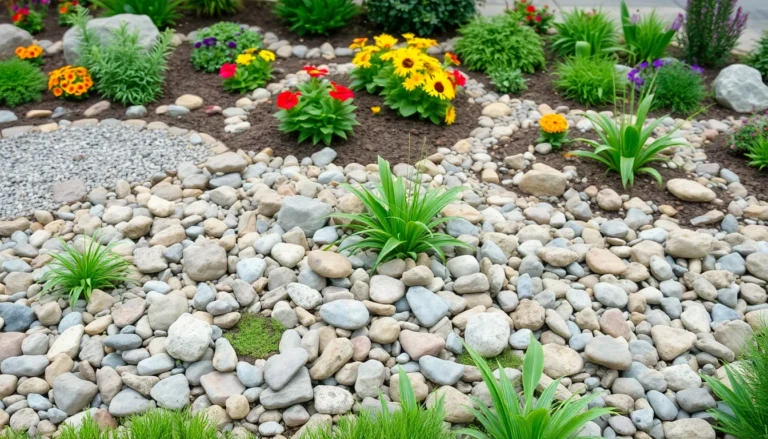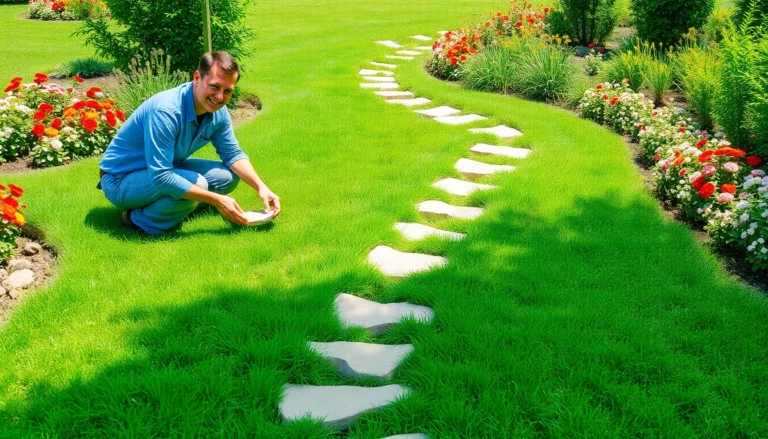As a landscaping enthusiast I’ve discovered that big rocks can transform an ordinary yard into a stunning outdoor masterpiece. These natural elements add drama texture and visual interest while requiring virtually no maintenance. Whether you’re looking to create a focal point build a retaining wall or design a rock garden large landscaping rocks offer endless possibilities.
I’ve seen firsthand how incorporating substantial stones into landscape design can solve common yard problems while boosting curb appeal. From massive granite boulders to limestone blocks these geological giants serve both practical and aesthetic purposes. They’re perfect for defining spaces controlling erosion and creating natural-looking transitions between different areas of your property.
Key Takeaways
- Large landscaping rocks come in three main varieties: granite boulders (24-72″”), limestone blocks (12-48″”), and river rocks (6-24″”), each offering unique benefits and applications.
- These natural elements serve both practical and aesthetic purposes, providing erosion control, creating focal points, and requiring virtually no maintenance compared to traditional landscaping features.
- When selecting rocks, size should be proportional to the space – 24-36″” for small yards, 36-48″” for medium areas, and 48-72″” for large properties, with proper spacing between stones.
- Professional installation is recommended due to weight and equipment requirements, with costs varying based on rock type ($50-300 per ton) plus installation fees ($100-500 per boulder).
- Large rocks create excellent features for rock gardens, water features, and retaining walls, while providing long-term value through durability and minimal maintenance needs.
Big Landscaping Rocks
Large landscaping rocks come in distinct varieties, each offering unique characteristics for outdoor design. I’ve worked extensively with these materials to create stunning landscape features that stand the test of time.
Granite Boulders
Granite boulders range from 24 to 72 inches in diameter with colors spanning gray, pink, black. I’ve installed these weather-resistant stones in focal points, creating dramatic visual impact through their crystalline texture. Granite’s density makes it ideal for retaining walls, water features, garden borders.
Key characteristics:
- Crystalline composition with speckled patterns
- Heat resistant up to 1,200°F
- Available in round, angular, flat-faced shapes
- Weight ranges from 150 to 2,000 pounds
Limestone Blocks
Limestone blocks measure 12 to 48 inches with buff, tan, cream color variations. I’ve incorporated these sedimentary rocks in garden walls, steps, edging due to their uniform cutting ability. The porous nature allows moss growth, creating an aged appearance over time.
Notable features:
- Rectangular cuts with precise edges
- Natural lime content benefits soil pH
- Stacks securely for walls up to 4 feet
- Weight varies from 100 to 800 pounds
River Rocks and Cobblestones
River rocks span 6 to 24 inches with smooth, rounded surfaces from water erosion. I’ve used these versatile stones in dry creek beds, drainage areas, accent borders. Their polished appearance adds natural elegance to water features.
- Smooth, tumbled surface texture
- Mixed colors including brown, gray, tan
- Ideal for water drainage paths
- Individual weights of 50 to 400 pounds
| Rock Type | Size Range | Weight Range | Common Applications |
|---|---|---|---|
| Granite | 24-72″” | 150-2,000 lbs | Focal points, walls |
| Limestone | 12-48″” | 100-800 lbs | Steps, edging |
| River Rock | 6-24″” | 50-400 lbs | Creek beds, borders |
Benefits of Using Large Rocks in Landscaping![]()
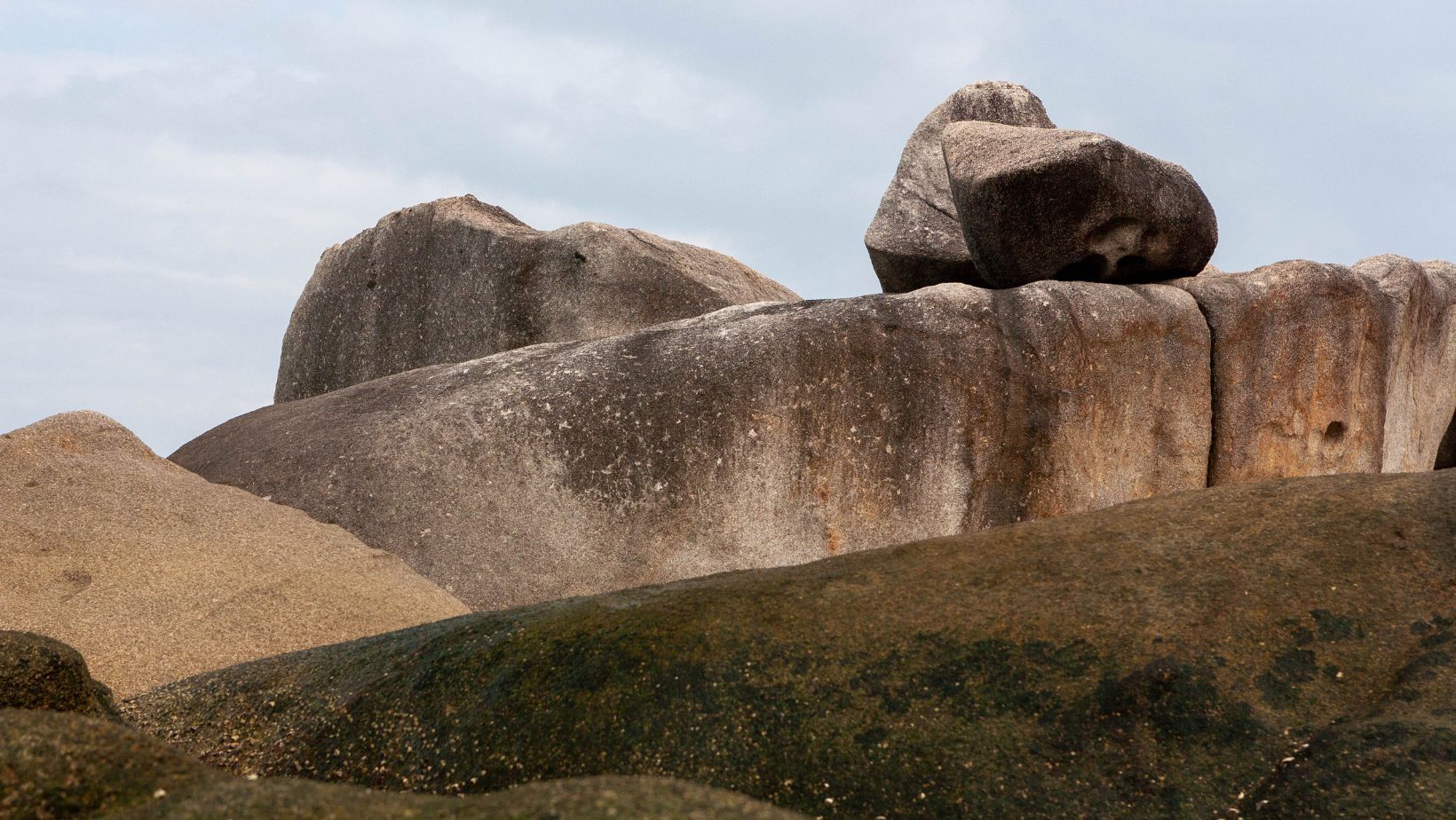 Large landscaping rocks deliver significant advantages in outdoor design through their durability, functionality, and aesthetic appeal. Here’s how these natural elements enhance outdoor spaces.
Large landscaping rocks deliver significant advantages in outdoor design through their durability, functionality, and aesthetic appeal. Here’s how these natural elements enhance outdoor spaces.
Visual Impact and Focal Points
Large rocks create instant focal points in garden designs through their commanding presence and natural textures. I’ve found that placing a 48-inch granite boulder near garden entrances draws the eye and establishes a strong visual anchor. These substantial stones complement existing plantings by providing year-round structure and creating dramatic height variations that break up flat landscapes. To help clients visualize the transformation before installation, I often use video animation to showcase different rock placements and landscape layouts in motion—making the planning process both engaging and effective.
Erosion Control Benefits
Large rocks excel at stabilizing soil and preventing erosion on slopes and hillsides. I position 24-36 inch boulders strategically along inclines to redirect water flow and anchor surrounding soil. These rocks form effective barriers against soil washout, particularly during heavy rainfall, while creating natural-looking terraces that enhance landscape structure.
Low Maintenance Features
Large landscaping rocks eliminate common maintenance tasks associated with traditional garden features. Unlike mulch that needs annual replacement, a properly placed 36-inch boulder remains stable for decades without fading or decomposing. I’ve observed these rocks require zero watering, trimming, or seasonal care while continuously suppressing weed growth in their immediate vicinity.
| Maintenance Comparison | Large Rocks | Traditional Features |
|---|---|---|
| Annual Cost | $0 | $150-300 |
| Lifespan | 50+ years | 1-5 years |
| Water Requirements | None | Moderate-High |
| Seasonal Care | None | 4-6 times yearly |
Popular Design Ideas with Large Rocks![]()
I’ve discovered numerous creative ways to incorporate large rocks into landscape designs, transforming ordinary outdoor spaces into stunning natural sanctuaries.
Rock Gardens and Formations
Rock gardens showcase strategic placement of large stones amid drought-resistant plants like sedum stonecrop rosettes sedums ornamental grasses. I arrange boulders in groups of 3-5 varying sizes, creating depth through elevation changes of 12-24 inches. Japanese-inspired Zen gardens feature large flat stones as stepping paths surrounded by raked gravel patterns. Alpine gardens combine towering 48-inch granite specimens with clusters of small flowering perennials nestled between rocks.
Natural Water Features
Large rocks enhance water features by framing ponds directing cascades creating realistic streambeds. I position 36-inch boulders along waterfall edges to craft 4-6 foot drops that produce soothing sounds. Flat limestone slabs 24-48 inches wide form natural-looking stream banks while river rocks line the bottom in graduated sizes from 6-18 inches. Incorporating partially submerged boulders at pond edges provides basking spots for wildlife habitat integration.
Retaining Walls
Natural stone retaining walls blend structural support with organic aesthetics. I build walls using 18-24 inch granite blocks staggered in a running bond pattern reaching heights of 3-6 feet. Limestone blocks sized 12×24 inches create formal geometric walls with precise joints perfect for modern landscapes. Incorporating occasional 36-inch boulder outcrops breaks up long wall sections while providing planting pockets for trailing vegetation.
| Wall Type | Stone Size | Max Height | Style |
|---|---|---|---|
| Boulder | 24-36″” | 4 feet | Natural |
| Cut Granite | 18-24″” | 6 feet | Rustic |
| Limestone | 12×24″” | 5 feet | Formal |
Selecting the Right Rocks for Your Space![]()
Selecting appropriate landscaping rocks requires careful consideration of the installation area’s dimensions and existing design elements. My experience with large-scale landscaping projects has shown that proper rock selection dramatically impacts the overall aesthetic and functionality of outdoor spaces.
Size and Scale Considerations
Large landscaping rocks create the most impact when their size aligns with the surrounding space dimensions. I recommend following these size guidelines:
- Select rocks 24-36 inches in diameter for small yards under 1,000 square feet
- Choose 36-48 inch boulders for medium spaces between 1,000-2,500 square feet
- Install 48-72 inch specimens in large areas exceeding 2,500 square feet
- Place rocks at least 3 feet from structures like houses foundations or retaining walls
- Position boulders 5-7 feet apart to create natural-looking groupings
| Space Size | Recommended Rock Diameter | Minimum Spacing |
|---|---|---|
| Small (<1,000 sq ft) | 24-36 inches | 3-4 feet |
| Medium (1,000-2,500 sq ft) | 36-48 inches | 4-5 feet |
| Large (>2,500 sq ft) | 48-72 inches | 5-7 feet |
- Match rock colors to architectural elements like roof shingles or brick facades
- Incorporate varied textures through combinations of smooth river rock granite speckled surfaces
- Select lighter-colored stones for shaded areas to enhance visibility
- Use dark-toned rocks in sunny spots to prevent glare
- Choose weathered surfaces for natural landscapes
- Pick cut stone faces for formal garden designs
| Rock Type | Color Range | Texture Profile | Best Applications |
|---|---|---|---|
| Granite | Gray to pink | Coarse, speckled | Focal points, walls |
| Limestone | Buff to white | Smooth, uniform | Steps, pathways |
| River Rock | Tan to brown | Rounded, polished | Water features, borders |
| Slate | Blue to black | Layered, rough | Modern designs, accents |
Installation and Placement Tips
Installing large landscaping rocks requires careful planning and proper equipment to ensure safety and optimal positioning. The following guidelines detail essential transportation methods and positioning techniques for successful rock installation.
Transportation Methods
Moving large landscaping rocks demands specialized equipment based on their size and weight:
- Use a skid steer with lifting straps for rocks weighing 200-2000 pounds
- Deploy a mini excavator with rock grapples for boulders up to 4000 pounds
- Employ a crane truck for rocks exceeding 4000 pounds
- Install wheel dollies under flat stones weighing 100-500 pounds
- Position wooden rollers beneath elongated rocks for manual movement
| Equipment Type | Weight Capacity (lbs) | Best For |
|---|---|---|
| Skid Steer | 200-2000 | Medium boulders |
| Mini Excavator | 2000-4000 | Large boulders |
| Crane Truck | 4000+ | Massive stones |
| Wheel Dolly | 100-500 | Flat stones |
| Wood Rollers | 100-300 | Elongated rocks |
- Set rocks 1/3 deep in the ground for stability
- Face flat surfaces toward viewing areas
- Create 3-5 inch gaps between grouped rocks
- Align natural strata horizontally for authenticity
- Position larger rocks behind smaller ones for depth
- Angle rocks 15-20 degrees backward on slopes
| Placement Type | Depth Ratio | Spacing (inches) |
|---|---|---|
| Single Boulder | 1/3 buried | N/A |
| Rock Groups | 1/4-1/3 buried | 3-5 between |
| Retaining Wall | 1/2 buried | 1-2 between |
| Slope Stability | 2/3 buried | 4-6 between |
Cost and Investment Considerations
Large landscaping rocks represent a significant upfront investment that varies based on size, type, and source location. I’ve analyzed the key cost factors to help make informed decisions about incorporating these features into landscape designs.
Rock Pricing Overview
| Rock Type | Size Range (inches) | Price Per Ton | Installation Cost |
|---|---|---|---|
| Granite Boulders | 24-72 | $100-300 | $200-500 |
| Limestone Blocks | 12-48 | $75-200 | $150-400 |
| River Rocks | 6-24 | $50-150 | $100-300 |
Transportation Costs
Transportation expenses increase with:
- Distance from quarry to installation site
- Weight of selected rocks
- Equipment requirements
- Access limitations to property
- Fuel surcharges
Labor and Equipment Fees
Professional installation includes:
- Heavy machinery rental ($200-600 per day)
- Skilled operator costs ($75-150 per hour)
- Site preparation ($150-400)
- Placement adjustments ($100-300)
Long-term Value Analysis
The investment delivers value through:
- Zero irrigation requirements
- No replacement needs
- Minimal maintenance costs
- Enhanced property value
- Erosion prevention benefits
Cost-Saving Strategies
I recommend these approaches to optimize expenses:
- Source rocks locally to reduce transport costs
- Purchase during off-peak seasons
- Bundle multiple rock installations
- Coordinate deliveries with other projects
- Select naturally weathered specimens
- Site preparation requirements
- Drainage modifications
- Landscape fabric installation
- Complementary plant materials
- Lighting requirements
- Ongoing maintenance supplies
I’ve learned through years of landscaping that big rocks are more than just decorative elements – they’re transformative features that can completely reinvent any outdoor space. Their enduring beauty durability and minimal maintenance requirements make them an exceptional investment for any property.
Whether you’re aiming to create a stunning focal point control erosion or build functional elements like retaining walls large landscaping rocks offer endless possibilities. I’m confident that with proper planning and the right selection these natural elements will enhance your landscape for generations to come.
Remember that successful rock landscaping starts with choosing the right stones for your space and ensuring proper installation. While the initial investment might seem substantial the long-term benefits and virtually maintenance-free nature of large rocks make them a smart choice for any homeowner.

